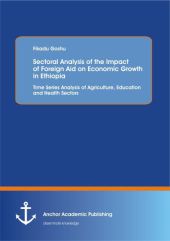 Neuerscheinungen 2015Stand: 2020-02-01 |
Schnellsuche
ISBN/Stichwort/Autor
|
Herderstra▀e 10
10625 Berlin
Tel.: 030 315 714 16
Fax 030 315 714 14
info@buchspektrum.de |

Fikadu Goshu
Sectoral Analysis of the Impact of Foreign Aid on Economic Growth in Ethiopia: Time Series Analysis of Agriculture, Educ
Erstauflage. 2015. 80 S. 220 mm
Verlag/Jahr: ANCHOR ACADEMIC PUBLISHING 2015
ISBN: 3-9548935-8-4 (3954893584)
Neue ISBN: 978-3-9548935-8-4 (9783954893584)
Preis und Lieferzeit: Bitte klicken
Text Sample:
CHAPTER ONE: INTRODUCTION
Chapter 1.1. Background:
Developing countries face challenges of massive poverty, slow Gross Domestic Product (GDP) growth, high mortality rates from illnesses, and low levels of education. More than 20 percent of the developing world (1.1 billion) people subsist on less than $1 a day. In some developing countries, such as those of Sub-Saharan Africa (SSA), more than 70 percent of the population lives in extreme poverty (i.e. the proportion of population earning less than $2 a day) (Kumler┤07, 2007; Leeson, 2008). The governments in these countries do not have sufficient financial resources to fight these challenges effectively. Foreign aid has played an instrumental role in the implementation of development programs to combat the challenges (Lohani┤04, 2004; Pattillo, Polak, & Roy, 2007).
Foreign aid is defined as any flow of capital to a developing countries for the objective that should be non commercial from the point of view of the donor on development, poverty reduction, or income distribution grounds and it should be characterized by concessional terms; that is, the interest rate and repayment period for borrowed capital should be softer (less stringent) than commercial terms (Bakare, 2011; Randhawa, 2012; Todaro & Smith, 2012). Official Development Assistance (ODA), commonly known as foreign aid is a flow of financial resources from developed countries to developing countries on development grounds (Eroglu & Yavaz, 2005; Moreira, 2005; Leeson, 2008; Paul & Pistor, 2009). It is an international transfer of public funds in the form of loans or grants either directly from one government to another (bilateral) or indirectly through multilateral assistance agency such as International Monetary Fund and World Bank (Radelet, 2006; UNCTAD, 2006; Abuzeid, 2009; OECD, 2009).
Similarly, Development Assistance Committee (DAC) defines ODA as a grants or loans to developing countries and multilateral agencies active in development that are undertaken by the official sector at concessional terms (if a loan, having a grant element of at least 25%), with the promotion of economic development and welfare as the main objective. Technical cooperation is also included in aid. Grants, loans, and credits to be used in military purposes are excluded (OECD, 2009; Paul & Pistor, 2009).
Despite the volume of ODA from bilateral and multilateral agency flows has grown from an annual rate of under $5 billion in 1960 to $50 billion in 2000 and then to over $128 billion in 2008, the percentage of developed country Gross National Income (GNI) allocated to ODA declined from 0.51 percent in 1960 to 0.23 percent in 2002 before improving to 0.33 percent by 2005 and then to 0.45 percent in 2008 as part of a campaign to increase assistance in the wake of the continued lag in human development in Sub-Saharan Africa (OECD, 2009; Paul & Pistor, 2009; Todaro & Smith, 2012).
Foreign aid is important source of finance in most countries in SSA where it supplements low savings, narrow export earnings and thin tax bases (Bhattarai, 2007; Arellano, BulÝ , Lane, & Lipschitz, 2009). Africa in general and SSA in particular receives a greater share of global aid than any other region in the world with East Africa receiving approximately 25 percent of all ODA to SSA. Within East Africa, Ethiopia receives the largest percentage (7%) of total ODA from all donors, followed by Tanzania (6%). According to OECD DAC statistics, aid to Ethiopia increased from US$1.1 billion in 1995 to US$3.5 billion in 2010 and is concentrated on core social sectors and infrastructure (Nganwa, 2013; Prizzon & Rogerson, 2013).
Most foreign aid is designed to meet one or more of broad economic and development objectives: to stimulate economic growth through building infrastructure, supporting productive sectors such as agriculture, or bringing new ideas and technologies; to strengthen education, health, environmental, or political systems; to support


